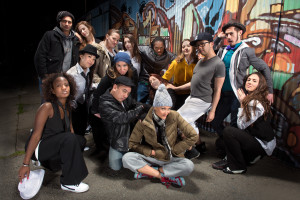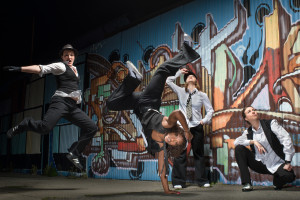
Photos by: David DeSilva
I remember first meeting Micaya backstage when I was volunteering for the San Francisco Hip Hop Dance Fest at the Palace of Fine Arts Theater in November 2010. Glamorous in a sparkly cocktail dress and high heels, Micaya greeted her technical crew and volunteers with a friendly smile. Onstage, Micaya rocked the microphone as an enthusiastic emcee. She drew lots of positive cheers from the crowd and encouraged everyone to attend the after party. The mix of dance companies showing work onstage gave me a key snapshot of hip hop’s creative reach.
When I Googled ‘hip hop dance’ on August 25, 2012, 278,000,000 results came up in addition to my 150 personal results. The first four results were a Wikipedia entry, followed by three YouTube videos: “hip hop dance class”, “hip hop dance competition” and “learn hip hop dance”. The fifth result was Micaya’s San Francisco Hip Hop DanceFest (the festival has added International to their title), acknowledged as the first festival dedicated specifically to honoring and recognizing the artistry of hip hop dance forms. This top Google result speaks to Micaya’s success in the international community of presenting hip hop movement on a concert stage.
Micaya | Festival Producer
Hip hop, as a dance form and practice, exists in both social spaces and theatres. In recent dance history, hip hop has garnered more attention from concert stages and art houses. To Micaya’s credit, numerous companies from around the world have performed on a concert stage at her annual event since 1999. In a SF Bay Guardian article honoring the Goldies winners of 2011, Rita Felciano writes about the award-winning SF Hip Hop Dance Fest and Micaya’s impact on hip hop. “She [Micaya] has single-handedly moved hip-hop from the studio and community hall to a proscenium theater, giving it widespread recognition and enthusiastic audiences. Uniquely, she has done so by honoring the art as a social activity and in its more theatrically evolved expressions.” I agree with Felciano’s accolades. In addition to providing hip hop dance companies with a unique opportunity to present work in a proscenium theater, Micaya celebrates hip hop’s social art form by holding a cypher for the dancers on the big stage. Plus, Micaya organizes after parties to keep room for improvisation and community gathering.
Micaya has been putting festivals together since 1993, when she began producing high energy, underground, sold-out hip-hop dance shows in San Francisco’s Mission District. She brings a true passion to her leadership as a festival producer. “To produce a festival, you must love the festival, otherwise it may not be worth it.” she said.
Micaya | Dance Teacher
Hip hop’s four defining elements consist of: breaking, MC, DJ, and graffiti. Furthermore, Micaya upholds hip hop’s 5th element “knowledge”. Micaya’s weekly dance classes are loved by her students. And she gives students and up and coming local talent a chance to perform at her annual June festival Mission in the Mix. One of her dance students Elena Ruggiero notes: “I love Micaya’s class, because of the diverse amount of people in her class. She has company members, first timers and committed regulars.. She wants people in her class to have a good time, but also expects them to work hard to achieve her choreography’s potential. Micaya also keeps her students on their toes by mixing a variety of dance styles and musical varieties of hip hop so no two dances are ever the same. Sometimes you get to rage and get out some aggression, while at other times, you slow it down and dance from your heart. Her choreography stems from emotional roots, which allows you to give a part of yourself, rather than just copying the steps.” A winner of the Bay Guardian’s Best of the Bay 2012 for dance instructor, Micaya has earned a great reputation as a hip hop dance teacher. Known for creating a welcoming atmosphere where you ‘Come in, leave your ego at the door and learn’, Micaya has cultivated a large following of dance students. Currently, she teaches at Dance Mission Theater and ODC in San Francisco and ROCO Dance Studio in Marin. Her advice to fellow dance teachers: “Remember to teach, not perform for your students.”

Pictured: SoulForce Dance Company
Photos by: David DeSilva
SoulForce | Artistic Director, Micaya
Hip hop dance, a cultural movement originating in the 1970s in New York City, continues to grow as an art dance and choreographic form, attracting a diversity of cultural perspectives. Borrowing elements from popular culture, acrobatics and multiple dance techniques, hip hop dance can offer performance a versatile, athletic approach to movement. Micaya’s company SoulForce express this fun, positive dimension of hip hop dance. In their performances, SoulForce shows joy, musicality, and a range of dance styles. Micaya started SoulForce in 2001. “I think I have always wanted my own dance company” she said, “The idea of having dancers to play with and create with makes me very happy.” Described as “witty, dramatic and emotionally nuanced” by Dance Magazine, SoulForce brings together dancers of diverse backgrounds to create inspiring works on stage.
SoulForce performs each year at the San Francisco International Hip Hop Dance Fest. In 2005, their piece “Break the Cycle” opened with an evenly spaced standing group of dancers, their feet spread shoulder width apart, their arms relaxed by their sides, their costumes decorated with American flags. An audio sample began of President George W. Bush’s voice: “There’s an old saying in Tennessee, I know it’s in Texas, probably in Tennessee, that says ‘Fool me once (pause) shame on (pause)… shame on you (pause) You fool me, you can’t get fooled again.” The dancers responded to the pauses in the audio by isolating gestures of their hands. They placed one hand over the heart, returned hands to relaxed position, repeated the placement of one hand over heart, then brought one hand to a forehead salute. This opening scene illustrates Micaya’s sense of humor and sharp attention to the power of subtle movements in unison. The next section of the piece had a remixed version of ‘The Star-Spangled Banner’, and was danced by a trio. They performed a fusion of dance moves: balletic leg articulations, jazz barrel jumps, waving, bboy/bgirl footwork, threading, freezes, and contemporary inversions. With the choreography constantly shifting quality and direction, the dancers showed off a skillful range of dynamics.
The following year at SFIHHDF, SoulForce presented ”All Things Love…Lust, Romance, and Betrayal”, which opened with a sensual female duet in the center spotlight. The dancers sequenced rolls and slides reminiscent of contact improvisation. They arrested their momentum into provocative shapes: a backbend kiss, a double straddle pose. Next, six dancers danced on low roller chairs, their chests popping, body parts rolling, and toes tapping in tandem with a sexy R&B song. The dancers manipulated their chairs with finesse: one dancer rolled the object with his foot to land in a chair freeze. Then, a dancer stood up on the rolling chair, the group rolled him downstage and caught him in a front dive at the end—their movement perfectly syncopating the landing with the drop of the beat. Another dancer, with support of the group, used the rolling chair as a platform to stick a freeze! The athletic dancers showed strength in musicality by attacking fast, crisp movements to match the alternating beats.
Precision and unison are popular compositional approaches to hip hop choreography. The techniques of hip hop dance encompass a large scope of dances (too many to mention here) as the training inherits and varies elements from the African diaspora, plus it always evolves with pop culture dances. SoulForce Dance Company is skilled at old school hip hop dance techniques such as party dances, uprocking, waving, locking and step, as well as in new style hip hop dance techniques, which involve hard hits, isolations, footwork and social dance steps. A great example of their fusion style was at the 2009 SFIHHDF in their piece “The Original Breath”, when the SoulForce dancers mixed slow pirouettes with the stocatto stops of a boogaloo. They exhibited a great combination of control, grace and rhythmic play.
When asked about her creative process with SoulForce, Micaya responded “I am inspired by the dancers that are in the room with me. Sometimes I have an idea when I walk into rehearsal, but it usually is not much more than that. Almost all of my choreography with SoulForce is done on the spot with them.” In addition to showing work at the SFIHHDF, SoulForce dancers have been featured in music videos, touring productions, nightclubs, festivals, corporate events, colleges, theatres and commercials.
Audiences can experience SoulForce’s fusion of hip hop and other dance styles at their Rotunda Dance Series performance at noon on Friday, October 5, 2012.
The 2012 San Francisco International Hip Hop Dance Fest will take place at the Palace of Fine Arts Theatre from November 16-18, 2012.
For more information, see:
soulforcedance.com | Facebook/Twitter: SoulForce Dance
micaya.com | Facebook/Twitter: MicayaSF
sfhiphopdancefest.com


